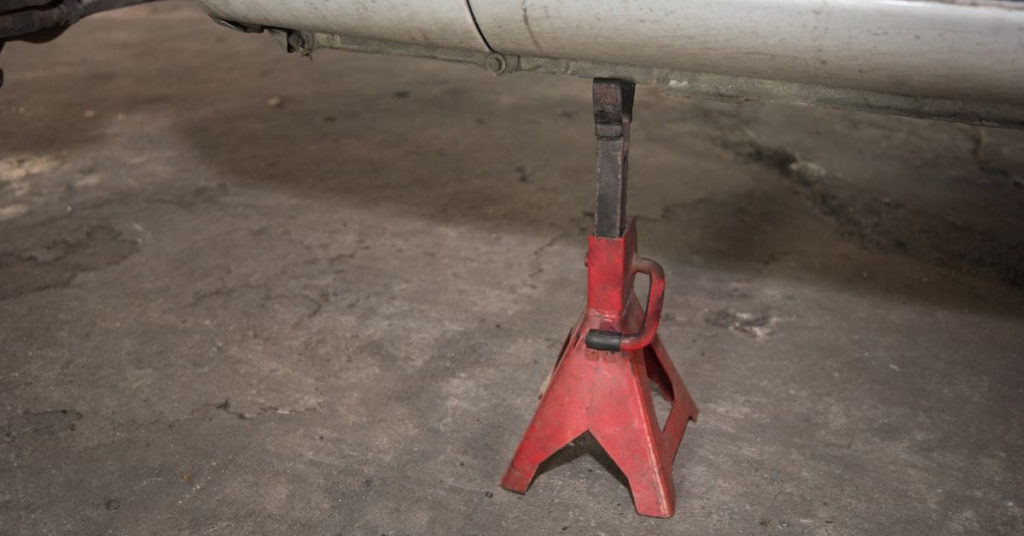Lifted trucks are highly popular for the four-wheel driving community but it can be hard to know how you get underneath to work on it. Due to the extra height, you cannot raise your truck with standard equipment and procedures.
In this article, we will tell you everything you need to know about jacking up your lifted truck, including a step-by-step guide towards the end.
What Tools Do I Need?
Before you read any further it’s important to have a clear idea of what materials and equipment you will need to jack up your truck properly and safely. If you don’t have these tools then go out and buy them, they will certainly come in handy for other mechanical work in the future.
So, what tools do you need?
- Jack – this is the device that will help you get your truck in the air. We will discuss which jacks work best in more detail in the section below.
- Wheel chocks – these are small pieces of hard plastic or wood that prevent the wheels/car from rolling away. If you own a camper trailer or caravan you should already have a set laying around.
- Jack stands – these are used to support the weight of your truck as it’s jacked up into the air. They are a small tripod shaped device that will ensure your vehicle is safe and steady above you as you work
With these tools lifting your truck will be easy and efficient anytime you need to do work in the future. They will also come in handy for lifting any kind of vehicle so if you have the money to invest in higher quality brands for these products, they are well worth the extra investment for the ease of use and value for money.
What Kind of Jack Should You Use for a Lifted Truck?
You must invest in the right kind of jack to ensure the safety of you and your truck as your work. This will be a one-time investment that you can use for years so be sure to buy a high-quality, name-brand jack to get the best value for money. Below are the best kinds of jacks that you can use for a lifted truck.
Hydraulic “trolley” jack
This is one of the most popular jacks for at-home mechanics looking for an easy to use, reliable, and safe way to lift their car while they work on it. Hydraulic jacks are easy to use and capable of lifting impressive weight loads making them perfect for a lifted truck. They are also easier to maneuver underneath the car ensuring you can quickly and efficiently access the undercarriage of your car.
Hi-lift/Trail jack
While these are less popular than a hydraulic jack, they offer more benefits in an off-road setting. They allow you to lift your truck on an angle which can help you get yourself out of trouble off-road. These will still give you all of the clearance and safety you need to raise your lifted truck. They are also easier to store than hydraulic jacks.
While other kinds of jacks like bottle jacks may appear to be better for storage and convenience, they may not give you the height you need to fully lift your truck. To use these, you may have to elevate them on bricks or slabs of wood which is dangerous and can damage you and your truck.
Sticking to a hydraulic or trail jack will ensure that you get all the height you need for quick and easy repairs and maintenance without sacrificing height.
Air Jack
Air jacks, also known as exhaust jacks or inflatable jacks are superb jacks for off-roading. These types of jacks work really well in tricky situations when off-road. The first benefit is they can be inflated by the exhaust on your truck. The next benefit is that they work well in extreme situations and on lifted trucks.
Air jacks generally have a high lifting point making them suitable for lifted trucks. They also do not require firm lifting points.
Where Do I Put the Jack on a Lifted Truck?
Where you position your jack is very important to safely and properly lift your vehicle. If you choose a faulty spot the truck can slip and fall potentially causing you and your truck damage.
Some trucks will have secure jacking points specifically added to the design of the vehicle. While these are generally easy to spot, they should be listed in the vehicle’s owner’s manual as well. These spots are the best option to lift your truck safely and securely.
If your vehicle does not have official jacking points it is essential that you carefully consider where you place your jack. You want to locate a level area that is big enough to fit the tip of the jack comfortably. This spot needs to be level so that your vehicle does not slip while you are working on it which can cause injury to you or damage to your vehicle.
You will also want to check that the area you choose to position the jack can support the weight of the vehicle. You should NOT position the jack under any mechanical components or elements of the car. Once you use the jack to lift the truck in the air the whole weight (well over 1 tonne in most cases) will be supported on the 1-2 places you select.
This can cause substantial damage to these components. You should also never put the jack under the body panels of the car as this will cause the car to slip and fall easily and can also damage the body panels of your vehicle.
If you cannot find official jacking points you will want to choose an even, unpainted section of the undercarriage that is free from any mechanical components. These spots can generally be found between the front and rear tires which are the best areas to lift your truck in general.
Step-By-Step Guide

Now we’ve got all that out of the road here is a step-by-step guide on how to jack your truck.
Step 1: Parking the car
Choose a stable, level surface with plenty of room to move yourself and your tools around as you work. If possible, parking on concrete will prevent slipping and may increase your comfort as you work.
Don’t forget to engage the parking brake to prevent the vehicle from rolling when you get it up in the air.
Step 2: Placing the chocks
The chocks will prevent the car from rolling as you work on it and are essential to your safety. Where you place them is dependent on what end of the vehicle you are lifting. If you are lifting the front of the car, place the chocks behind the rear wheels to prevent the vehicle from rolling backward.
If you are lifting the back of the vehicle, place the chocks on the wheels to prevent the vehicle from rolling forward.
You should secure the chocks firmly against the tire. This will prevent the car from moving once you get it elevated in the air.
Step 3: Check your jack is functioning properly
This will be more relevant to those with a hydraulic jack but is a general rule of thumb for all jacks. Going over the jack and checking that you have all of the equipment prepared and close at hand will ensure there are no unexpected emergencies when you get your vehicle in the air.
If you are using a floor jack you should also check that the pressure relief valve is shut off to prevent issues as you jack the vehicle.
If your jack appears to be damaged or missing any components then you mustn’t use it until you sort out repairs or a replacement. A faulty jack can slip or snap which can cause the vehicle to fall on top of you as you work. You mustn’t ignore physical signs of damage or stress as this can have dire consequences for you and your vehicle if it breaks further while in use.
Step 4: Positioning your jack
You will want to position your jack under whichever side of the vehicle you are looking to gain access to beneath. If you want to do work under the front of the truck then lift the front of the vehicle. If you want to work under the back then lift the back.
Don’t forget to use secure jack points as explained earlier in the article to ensure your vehicle is safe and secure as you work.
If possible, using two jacks in different areas of the vehicle (e.g., driver and passenger side) will increase the support and stability of the vehicle but you can generally get away with only using one jack for most work.
If you do have two jacks you can also lift the entire vehicle off the ground by positioning one and the front and one at the rear of the vehicle. This will make working on the vehicle extremely easy and ensures you do not have to constantly reposition the jack on more complicated jobs.
Slide the jack underneath the vehicle and make sure it aligns with your chosen jack points. If you are looking to raise the front of the vehicle you will want to position the jack behind the front wheel. If you are looking to raise the back of the vehicle you will want to position the jack in front of the wheel.
Step 5: Raising the jack
Once you are sure you have correctly positioned the jack you can begin raising the truck. With a hydraulic jack, you will only need to pump the handle and the jack will do the rest. Pause after you raise the vehicle a few inches to check that the jack is firmly secured on the jack point and is not going to slip as you raise it higher.
If you need to adjust the positioning you can release the pressure valve before shutting it back off to repeat the process until you are sure you will be able to raise the vehicle safely.
Step 6: Placing jack stands
After you get the car jacked up you can place the jack stands on the appropriate side of the wheel you are looking to raise. You can then lower the jack and the stands will keep the vehicle raised securely as you work.
Step 7: Removing jack stands when you are finished
When you are finished working on the vehicle you can repeat steps 4 and 5 to jack the vehicle back up. This will allow you to remove the jack stands so you can lower the truck in the next step.
Step 8: Lowering your truck
As the final step, you can lower your truck by slowly releasing the pressure valve on your jack. This will bring the vehicle slowly and safely to the ground. You can then remove the chocks and you are good to go back to enjoying your vehicle!
Conclusion
With the right equipment raising your lifted truck is an easy and safe process that will take you no time at all. Investing in high-quality tools like those mentioned in the article will ensure it is a quick and safe process for you and your vehicle.
By taking your time to carefully follow our step-by-step guide you will be able to easily and safely raise your lifted truck in no time!
- Tips and tricks For Setting Up Camp Like a Pro - September 11, 2023
- The Best Multi-Tools for Overlanding Adventures - August 25, 2023
- Off-Road Navigation Tips for Overlanders - August 13, 2023


